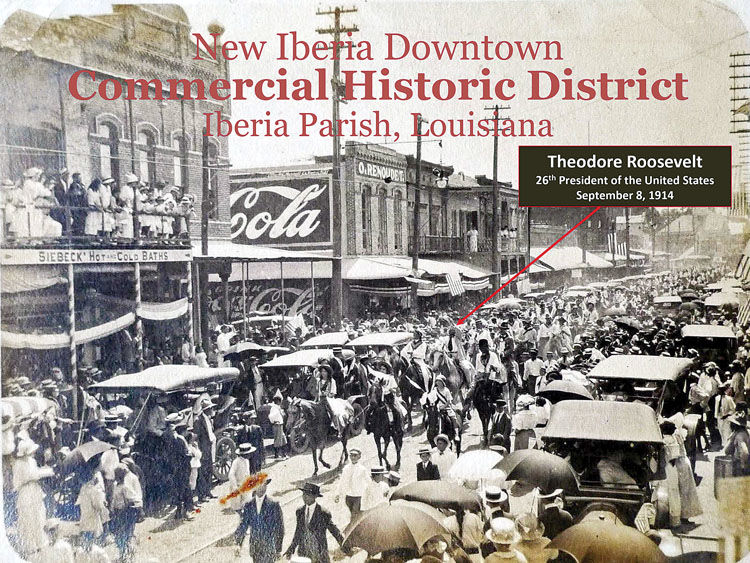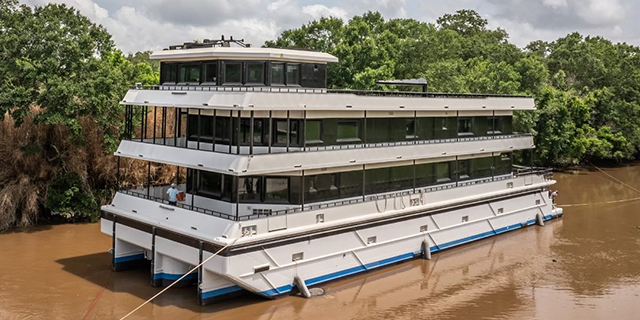The Queen City’s Crown
Published 7:00 am Tuesday, March 20, 2018

- The Queen City’s Crown
New Iberia’s Main Street – A National Register Commercial Historic District
Hailey Hensgens Fleming | Submitted Photos
Ask any local resident or tourist, alike, and they’ll tell you there’s something special about downtown New Iberia: the architecture, the atmosphere, the glimpse of history present in every glance. On December 13th, 2017, it was made official as New Iberia’s Main Street area earned the impressive designation of a National Register Commercial Historic District – a notable accolade that not only confirms the historic importance of the Queen City, but also holds promising implications for its future.
As you can imagine, the application to receive this honor was extensive, requiring the attention and efforts of several local individuals who volunteered their time to see the project through to completion. One of the key players in the process was Jane Braud, the Director of New Iberia’s Planning and Zoning Department and certified Main Street Program Director. She explains the catalyst for such an endeavor came when the CNO of Cane River Pecan Company, Jady Regard, invested in an old building on Main Street with intentions to relocate some of his operations.
“We were so excited about his plans and we wanted to help him apply for all of the tax credits and incentives that we could,” she says. But in order to receive these tax credits, the building first had to be listed on the National Register of Historic Places. In the process, however, rather than list one individual building, they chose to expand and list the entire district, as the majority of the structures would easily meet eligibility requirements.
It was an easy jump to make as Mayor Freddy DeCourt, who had just assumed office in January, had personally taken advantage of state tax credits in the past and viewed a national designation as the next level in the revitalization of the district. “For the size of our town, we really have a lot historic properties in our downtown so, it’s something I always wanted to look into,” he explains. “My whole push is to get new businesses here and to get us growing again. So, I thought it would be a great catalyst, especially when we’re so blessed to have such a really nice historic district in our downtown already.”
When applying for consideration, a building had to meet certain criteria in order to be considered a “contributing element.” Paul Allain, a local architect and Main Street property owner who volunteered his time to assist in the application, explains, “These qualifying buildings were of a certain age, architectural style and were not changed through a renovation that would have destroyed the original architectural styles.” A few such structures were the Wormser’s and Poncio’s buildings as well as the Gouguenheim. Additionally, perhaps a less obvious qualifying factor would be if a historic or notable event had taken place in the building.
Historic data, photographs and detailed information had to be gathered on each of the 123 buildings located within the proposed district, requiring the extensive efforts of Braud, Allain and Mayor DeCourt. “A lot of the background that was required was based on a survey and mapping of the existing district, especially in regard to the architecture and the style of architecture that exists downtown in multiple buildings,” explains Allain. “We had to provide the period of significance, as much as we knew about the style of architecture, the circa date for when the building was built and who the architect or contractor was,” he adds. After collecting the necessary data, of the 123 buildings listed, 82 were deemed significant contributors to the district, with 7 of those having been previously listed.
Following a full year of work, Braud and Allain made a presentation to the State Review Board in June of 2017 that was met with unanimous approval. The application was then passed on to the National Park Service who officially approved the district on December 13th.
Besides bragging rights, the benefits of the new designation are two fold: tax credits and tourism. As per the original intent of the application, potential investors within the district can now take full advantage of federal and state tax credits as well as tax abatements and grants toward the rehabilitation of historic structures. Jade Braud elaborates, “If you add all those incentives together it’s a big carrot when you’re trying to attract business owners or there are buildings for sale. You add that to the marketing information and it’s a huge incentive.”
For the City of New Iberia, which has taken on the initiative of bringing business back to the area, these incentives offer great promise. DeCourt weighs in, “The tax credits are huge! I’ve already been reaching out to developers and have some that are at least inquiring and interested.” When asked how the new designation progresses his agendas he answers, “I think it’s the combination of giving incentives and doing these tax credits as well as trying to make us a one-stop-shop that is more friendly for developers. We’re beginning to market ourselves differently and that’s beginning to pay off.” He adds, “We are open for business.”
For Allain, it was also an opportunity to preserve the past, “We understood it could have quite an economic impact for the district and it could quite possibly be the catalyst to save a number of historic structures from blight, demolition and neglect,” he explains. “In the big picture we knew how important this was because we’ve seen it in action in different communities, whether in New Orleans, Crowley or other municipalities that have taken advantage. They have these downtown historic districts and they have been able to incentivize the refurbishment and rehabilitation of these old structures for adaptive reuses. And, that’s just an important part of the type of architecture we do, which is preservation architecture.”
Breathing new life into these old structures is essential for an area that represents the lifeblood of the community as well as a central tourism attraction. “Our fairs and festivals and all of our community activities take place in the downtown area: our art walks, the museum, Ipal. There’s just so much to offer,” says Braud. “Our downtown is an attraction within itself,” she adds, “and we have so many notable tourist attractions, like the Shadows, Jefferson Island, Avery Island and Conrico Rice.”
Combined with the National Historic Register Residential District along East Main Street, the newly designated commercial district solidifies the Queen City’s prominence on a national level. “Being a National Register District is a big deal,” says Braud. “It means we’re being recognized throughout the country as having two districts and there are tourists who come to visit just to look at the architecture, the history, the culture and the food. Everything about it just brings people in.”
It’s this kind of allure that has drawn the eye and captivated the hearts of those who visit. And, it’s what keeps them coming back. Just ask last year’s 600 Cycle Zydeco participants who voted New Iberia their favorite stop on the cycling route. This year, the newly designated historic district will be prepared to host more than 800 of them as they return to the spot they couldn’t get enough of – proving what the locals already know. “New Iberia has so much to offer to our tourists and residents,” says Braud, “and I couldn’t be prouder of my city.”





